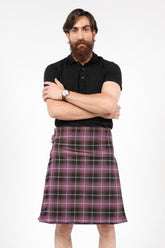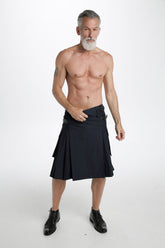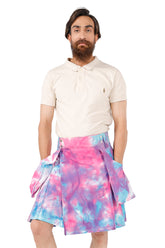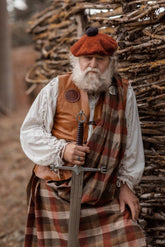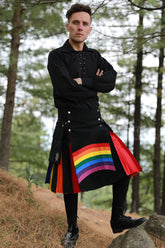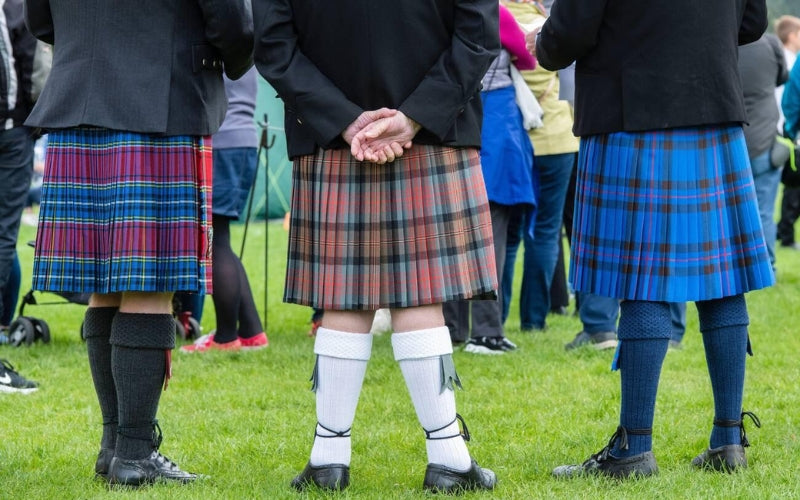Tartan Kilt - All You Need To Know About Poly-Viscose Fabric
What is Tartan Kilt?
A tartan kilt is a garment that resembles a wrap-around knee-length skirt, traditionally made of twill-woven worsted wool with heavy pleats at the sides and back, and featuring a tartan pattern. Tartan is a patterned cloth consisting of criss-crossed, horizontal and vertical bands in multiple colors, forming simple or complex rectangular patterns, which serve as a symbolic representation of Scottish heritage and clan affiliation, with distinct patterns associated with specific clans. Today, the tartan kilt is still worn for formal occasions and is a symbol of Scottish heritage and pride.
Tartan Kilt History:
The tartan kilt is a traditional Scottish garment that has a rich history dating back centuries. The earliest known reference to the kilt dates back to the 16th century, but it wasn't until the 18th century that the kilt became widely popular in Scotland. The kilt was originally worn as a full-length garment, but it was later shortened to the knee-length style that is still worn today. Each clan in Scotland has its own unique tartan pattern, which is used to identify members of the clan. Kilt History encapsulates a timeline marked by rebellion, resilience, and cultural pride. From the battlefield to contemporary fashion runways, the kilt's enduring legacy showcases a sartorial emblem that transcends time. The kilt has a long history in Scottish Highland dress and has become associated with the wider culture of Scotland, as well as with Gaelic or Celtic heritage.
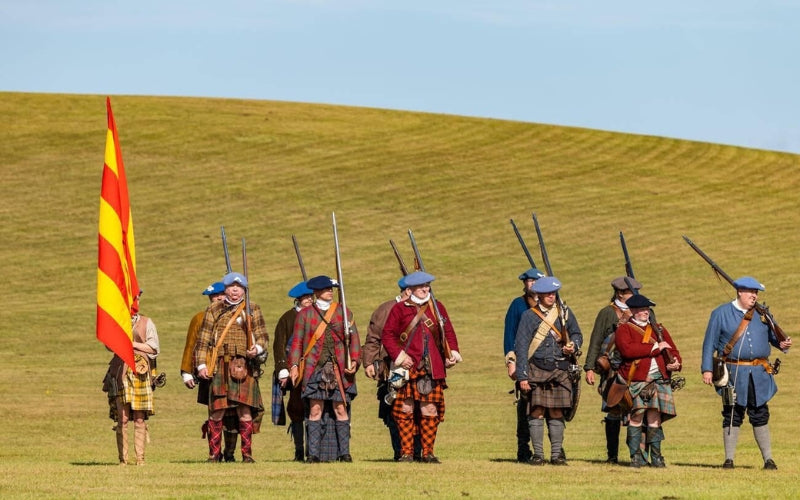
Traditional vs Casual Kilt:
Traditional Kilt:
The traditional kilt, also known as the 8-yard tartan kilt, is a symbol of Scottish heritage and pride, often worn at formal events, weddings, and Highland games. It originated in the 16th century in the Scottish Highlands, initially serving as a garment for warmth and protection. Traditional kilt is made of the finest acrylic wool, it reflects tartan's authentic history and is available in various colors and patterns to match individual style preferences.
Casual Kilt:
On the other hand, the casual kilt, typically a 5-yard kilt, offers a more budget-friendly option compared to the traditional 8-yard kilt. It is designed for everyday wear and informal gatherings, sitting lower on the waist, similar to trousers, and using less fabric. Crafted from premium acrylic wool, it connects wearers to the rich cultural history and traditional style of Scotland, providing authenticity.
What is a Tartan Kilt made of?
A tartan kilt is traditionally made of acrylic wool, featuring a patterned cloth with criss-crossed, horizontal, and vertical bands in multiple colors, forming simple or complex rectangular patterns. However, modern tartans can also be made from poly-viscose, a fabric that maintains the aesthetic appeal of traditional wool tartans while offering a comfortable and authentic alternative for those who prefer non-wool options. The fabric's design, look, and feel make it suitable for achieving the perfect kilt without sacrificing authenticity. Tartan is a significant symbol of Scottish culture, with over 7,000 unique tartans on record, each representing different clans and families.
What is the History of Poly Viscose?
Poly Viscose, a blend of viscose and polyester, has a rich history dating back to the creation of viscose in 1883 in France. Initially popularized in the 1910s, viscose is a man-made natural plant-based cellulose fiber, while polyester is known for its wrinkle and shrink resistance. The combination of these two elements results in a durable and breathable fabric, making polyviscose an ideal choice for various products, including tartans, dresses, blouses, and upholstery. This fabric is also valued for its environmental benefits, as it is plant-based and does not come from animal sources, making it a popular choice for vegans and those with wool allergies or sensitive skin. Polyviscose's versatility, cost-effectiveness, and durability make it a sought-after material for a wide range of applications.
Composition of Poly-Viscose Fabric:
What is Viscose?
Viscose, a semi-synthetic fiber, derives from wood pulp, presenting a natural feel. Recognized for its breathability and absorbency, it's a popular choice in textile production.
What is Polyester?
Polyester, a synthetic polymer, offers durability and resilience. Renowned for its wrinkle resistance and quick-drying properties, polyester enhances fabric longevity.
How are Viscose & Polyester blended to make Poly-Viscose Fabric?
The fusion of viscose and polyester combines the best of both fibers. This blend harnesses the comfort of viscose with the strength of polyester, resulting in Poly-Viscose Fabric—a versatile material prized for its softness, durability, and adaptability in diverse garment applications.
Drawbacks of Pure Wool:
Pure wool has some drawbacks that should be considered before purchasing wool products. One of the main drawbacks is that it can be expensive compared to other materials. Additionally, it can be itchy and uncomfortable to wear, especially for people with sensitive skin. Wool is also prone to shrinking and requires special care when washing and drying. Finally, it is not as durable as synthetic materials and can wear out more quickly. Despite these drawbacks, it has many benefits, including its natural water resistance, wrinkle resistance, and insulation properties.
Versatility and Comfort of Poly-Viscose:
Poly-viscose fabric is a versatile and comfortable material that combines the best qualities of viscose and polyester. Viscose, a plant-based material, provides a natural feel similar to wool, while polyester adds durability and wrinkle resistance. This blend creates a fabric that is nearly indistinguishable from traditional wool, making it a cost-effective and practical alternative. Poly-viscose is machine washable, making it easy to care for, and it drapes beautifully, making it suitable for a wide range of clothing and upholstery. It is also robust and has better wicking and breathability than most artificial fibers, offering a high level of comfort.
Poly-Viscose in Outlander Kilts:
Poly-viscose fabric is a key component of Outlander kilts, aligning with the design, look, and feel of the show's iconic attire. Celebrated for its lovely feel, durability, and machine-washable nature, the poly-viscose tartan fabric used in Outlander kilts is a 65/35 blend of polyester and viscose, woven to a weight of 12 oz. This fabric is non-felting, non-pilling, and hypoallergenic, retaining the natural aesthetics of wool while offering practical benefits.
Poly-Viscose Kilt Design and Care:
Poly-viscose kilts are made from a blend of polyester and viscose, offering a cost-effective and versatile alternative to traditional wool kilts. The fabric is known for its silky smooth texture, breathability, and durability, making it suitable for various climates and activities. When it comes to care, poly-viscose kilts can be hand-washed or sent to a dry cleaner for maintenance, ensuring their longevity and quality. While poly-viscose kilts may be less durable than wool kilts, they are a practical choice for those seeking a more affordable option or living in warmer climates. Overall, poly-viscose kilts provide a comfortable and stylish option for kilt enthusiasts.
Budget-Friendly Option:
Fashion Kilt, your go-to choice for a budget-friendly and stylish kilt, offers a diverse range of options without compromising quality. Emphasizing both craftsmanship and affordability, We ensure that when you decide to buy a kilt from us, you get exceptional value. Explore the collection today to discover the perfect blend of tradition and cost-effectiveness that sets Fashion Kilt apart as the ideal choice for those seeking quality kilts without breaking the bank. Delve into an extensive selection featuring dozens of unique tartans tailored to suit your individual preferences. Secure yours today and immerse yourself in the unparalleled quality meticulously woven into each of our kilts.
FAQs
What is Poly-Viscose Fabric, and Why is it Used in Tartan Kilts?
This fabric is a blend of polyester and viscose, known for its durability and soft texture. In the context of Tartan Kilts, this fabric offers a practical solution by combining the strength of polyester with the comfort of viscose.
How does poly-viscose fabric compare to wool?
Poly-viscose fabric is a good substitute for wool, especially for those who have an allergy to wool or are looking for a more cost-effective and versatile material. Poly-viscose fabric has a wool-like texture and is silky smooth to the touch. It is also more durable than wool and does not shrink at normal temperatures. However, wool is a fully natural fiber that is more breathable and has better insulation properties than poly-viscose fabric.
What are the benefits of poly-viscose kilts?
Poly-viscose kilts are a cost-effective and versatile alternative to traditional wool kilts. The fabric is known for its silky smooth texture, breathability, and durability, making it suitable for various climates and activities. Poly-viscose kilts can be hand-washed or sent to a dry cleaner for maintenance, ensuring their longevity and quality. While poly-viscose kilts may be less durable than wool kilts, they are a practical choice for those seeking a more affordable option or living in warmer climates.
Are Poly-Viscose Kilts Suitable for All Occasions?
Poly-viscose kilts blend durability with sophistication, making them versatile for any occasion. Whether it's a formal event or a casual gathering, these kilts effortlessly combine style and comfort for a polished look that suits every affair.
How to Care for Poly-Viscose Tartan Kilts to Ensure Longevity?
To ensure the longevity of Poly-Viscose Tartan Kilts, adhere to recommended care guidelines by gently hand washing with mild detergent and avoiding prolonged exposure to direct sunlight while storing in a cool, dry place to maintain fabric integrity.

